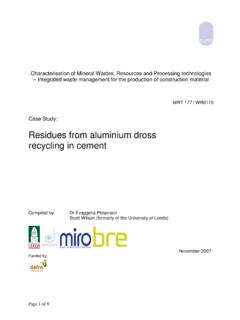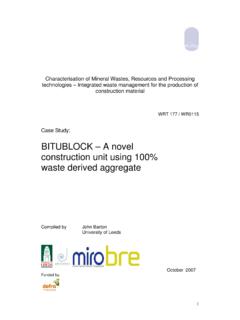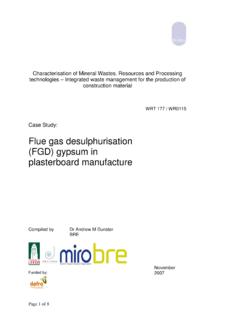Transcription of Industry Sector Study - SMARTWaste
1 Characterisation of mineral Wastes, Resources and Processing technologies Integrated waste management for the production of construction material WRT 177 / WR0115 Industry Sector Study : mineral wool insulation Funded by: October 2007 Industrial Sector Study on the utilisation of alternative materials in the manufacture of mineral wool insulation Compiled by Dr Andrew Dunster Building Technology Group BRE (DEFRA Project Code WRT_177 / WRO115) September 2007 -1- Contents 1.
2 2 2 . The mineral wool manufacturing Sector in the 2 Process overview .. 2 Products and markets .. 4 Sustainability issues and mineral wool 3 . Alternative raw material usage in the mineral wool manufacturing 6 Key requirements .. 7 Substitute materials .. 8 Characterisation Framework .. 10 Standards and protocols .. 10 4 . Guidance on assessing alternative raw materials for the mineral wool manufacturing Waste 10 Future developments .. 11 5 . Overview roadmap for utilising alternative materials in the mineral wool manufacturing 11 Industry 11 Roadmap.
3 12 -2- 1. Scope This report describes the results of an assessment of the role of alternative raw materials derived from mineral wastes in manufacture of mineral (or stone) wool . The report reviews the manufacturing processes and markets for the material, sustainability issues in the Sector , and the utilisation of alternative raw materials. It also describes the key properties that are required of the raw materials, reviews current waste exchange mechanisms and recommends characterisation frameworks.
4 It also mentions relevant standards and quality protocols to encourage wider utilisation of mineral wastes. The report focuses on mineral (stone) wool products. Glass wool (which requires high purity feedstocks) and organic insulation are touched upon in the context of the demand for insulation products, but otherwise are beyond the scope of this document. Furthermore, glass recycling is well covered by the Waste and Resources Action Programme (WRAP)[1], [2]. 2. The mineral wool manufacturing Sector in the UK overview mineral wool (or stone wool ) is a non-metallic, inorganic product manufactured using stone/rock (volcanic rock, typically basalt or dolorite)* together with blastfurnace or steel slags as the main components (typically 97%).
5 The remaining 2-3% organic content in the product as sold is generally a thermosetting resin binder (adhesive) and a little oil. In the manufacture of mineral wool insulation, rock material and two slag materials - (blastfurnace slag and steel slag) are melted in a cupola furnace at approximately 1500 C. The two types of slag act as a flux to help the molten rock flow and lower the melting temperature. Formstones are also added; these are manufactured briquettes composed of mineral wool process and product waste, processed by rod-milling the waste into dust and binding it together with binders such as starch and lime.
6 The fuel used has a high calorific value and is usually coke. The molten mixture is spun to give a mineral wool with a fibre-like structure. Manufacturers are also prepared to consider raw materials to provide alternative sources to primary rock, flux or fuel [3]. The production process for mineral wool insulation is illustrated in Figure 1. The various inputs to the process are shown in Figure 2. * Basalt, dolerite and gabbro are all naturally occurring rocks with broadly similar chemical and mineralogical composition, differing mainly in the grain size of the minerals.
7 -3- Figure 1: Schematic of the manufacture of mineral wool (source Rockwool website) Figure 2: Characterisation Framework on the utilisation of alternative raw materials in mineral wool manufacture -4- Products and markets mineral wool can be manufactured to many different densities to give varying properties, formed into shapes and faced with a variety of sheet materials. Products range from loose material used for the injected insulation of cavity walls, slabs for walls and rolls for loft insulation through to pre-formed and faced pipe sections (laminated matting).
8 Insulation is used to save energy, combat noise, reduce the risk of fire and protect property and life in the event of fire. The main drive currently is to reduce energy use in buildings, with a recently increased emphasis on acoustic insulation, particularly of floors and party walls. Many products cover all uses they are effective as thermal and acoustic insulation, with fire retardant/ prevention properties. Insulation is used for: Cavity wall insulation built into a new building by design, or retro-fitted in existing buildings (as mats, board or blown) Solid wall insulation internal products include flexible thermal lining, thermal boarding (plasterboard with backing of insulation) or fibre based, though less popular due to thicknesses required external products polymer-based boards generally used (phenolic)
9 On outside of properties, which are then rendered/ finished to give normal appearance Structural Insulated Panels (SIPs) manufactured from either a timber or steel frame, usually with a polyurethane foam or mineral wool core Loft/Roof insulation mats, board or sprayed Flat roof insulation usually as integral boards Insulating heating systems and hot and cold water services (ducting and pipe work) several manufacturers offer tailored products suitable for ducting and pipe work, in both polymer-based materials and in mineral wool .
10 The market demand for building insulation in general is met by many products. These can essentially be classed into three main types inorganic ( mineral wool ) fossil organic ( polyurethane) or natural organic ( cellulose). Examples of the main types of insulation types and some of the main manufacturers are given below: Inorganic mineral wool (UK manufacturers: Rockwool , Knauf) Rockwool manufacture utilises slags derived from metals smelting as part of their recycled content. They also recycle production waste.






